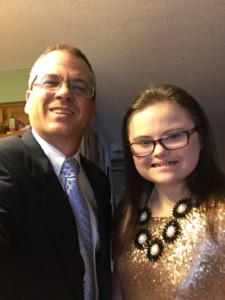
More is better, right? Why settle for 72 ounces of ketchup at the big-box store when you can get 84? But what about an extra chromosome? When you get an extra copy of the 21st chromosome, the world calls that Down syndrome and labels you with a disability, no matter how terrific you are. The world says individuals with disabilities can't do this and can't do that. This is where the world is wrong.
My 16-year-old daughter Rachel has Down syndrome, but it does not define who she is. She serves on her high school’s student council. She has been in 17 plays and a documentary and is on the honor roll with a 3.5 GPA. Rachel and others with Down syndrome may not fit the mold of what the world considers “normal,” but what is normal anyway? My daughter and millions of people like her don’t let labels and the associated stigmas hold them back.
October is National Disability Employment Awareness Month, a time devoted to exploring disability employment issues and celebrating the many contributions of Americans with disabilities in the workplace. Regrettably, the deck is stacked against those labeled as having physical or cognitive disabilities. Various sources report slightly different numbers, but according to the Bureau of Labor Statistics’ most recent data, “the unemployment rate for persons with a disability was 12.5 percent in 2014, about twice the figure of 5.9 percent for those with no disability.” There are numerous ways to slice the data, but it’s likely that many more people never even pursue employment because of the overwhelming odds and the very real employment issues facing individuals with disabilities.
All businesses – large and small – can benefit from an inclusive culture and providing opportunities for individuals with disabilities. Walgreens has been recognized for creating an outstanding work model for employing people with physical and cognitive disabilities. Their disability and inclusion program has proven to be both socially and economically successful. On a much smaller scale, the local smoothie shop in my town understands the value of hiring employees with disabilities, and Rachel made me very proud when she started her first job there this past summer.
Here at Sedgwick, we well know that the ability to work gives people a sense of purpose, allows them to support themselves financially, and improves their physical and mental wellbeing. Day in and day out, Sedgwick colleagues shape the experience of millions of Americans with disabilities by alleviating the intimidation and exclusion they may be feeling during the claims process. Our job is to advocate for our clients’ employees with a variety of disabilities as they navigate the health care system, family and medical leave, workplace accommodations and transitioning back to work after an injury or illness. With every claim and case we handle, we aim to deliver outstanding customer service, connect with people as individuals, and take care of them the way they want to be treated.
Within our own organization, we have a diversity and inclusion council with representatives from across the company who work together to help us leverage our diverse talent, promote the inclusion of ideas, and foster an environment of engagement, fairness and respect. The council also works to ensure that Sedgwick continues to reflect the organizations and individuals we serve, and this includes expanding employment opportunities for candidates with different cultural backgrounds and physical or intellectual disabilities. So far, we’ve focused on military veterans and others who may have suffered a physical disability or are dealing with post-traumatic stress disorder. Our long-term vision is to create a formal program for including those with cognitive disabilities in our workforce; making this dream a reality obviously has great personal significance for my family. While Sedgwick doesn’t yet have all the answers or a defined model, what we do have is a commitment to maximizing the inclusiveness of our culture so we can best serve our customers and business partners.
So, how can you promote inclusion in your organization’s workforce? I continue to draw on my personal experience. Throughout her schooling, Rachel has always been “included” in general education classrooms, but it takes a lot of collaboration and partnership. Rachel often has to work twice as hard as her peers to meet the academic demands, but she puts in the work because she wants so much to succeed and to be part of her school and community. People with disabilities want the same things as those of us who are not labeled as such – to have a job, contribute, and have value.
Jonathan Mast, Director Social Media Sedgwick